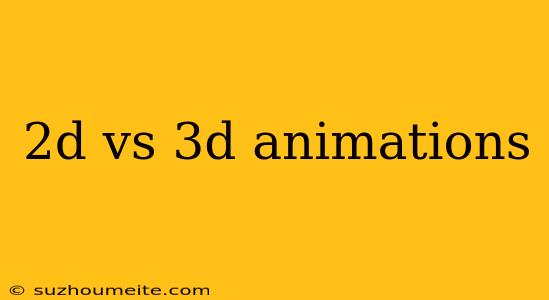2D vs 3D Animations: What's the Difference?
Animations have come a long way since the early days of hand-drawn cartoons. With the advancement of technology, we now have two primary types of animations: 2D and 3D. While both types have their own unique strengths and weaknesses, they are often used for different purposes and offer distinct visual experiences. In this article, we'll delve into the world of 2D and 3D animations, exploring their differences, advantages, and applications.
What is 2D Animation?
2D animation, also known as traditional animation, is a technique that involves creating the illusion of movement by arranging a series of static images in a sequence. Each image is hand-drawn or digitally created, with slight variations between them. When played in rapid succession, the images create the illusion of movement.
Characteristics of 2D Animation:
- Flat, two-dimensional characters and environments
- Limited depth and perspective
- ** Often features bold lines, vibrant colors, and exaggerated movements**
- Traditional hand-drawn techniques or digital drawing software are used
What is 3D Animation?
3D animation, also known as computer-generated imagery (CGI), uses three-dimensional models and environments to create the illusion of movement. Unlike 2D animation, 3D animation involves creating a virtual world with depth, width, and height. Objects and characters are modeled, textured, and animated within this virtual space.
Characteristics of 3D Animation:
- Three-dimensional characters and environments with depth and perspective
- Can create realistic simulations and complex movements
- Often features realistic lighting, shading, and textures
- Computer software and algorithms are used to create and animate 3D models
Key Differences Between 2D and 3D Animation
Visual Style
2D animation features a flat, two-dimensional look with bold lines and vibrant colors. 3D animation, on the other hand, offers a more realistic and immersive experience with depth and dimensionality.
Production Process
2D animation involves hand-drawing or digitally creating individual frames, which can be a time-consuming process. 3D animation uses computer software to create and animate 3D models, allowing for faster production and more complex movements.
Realism
2D animation often exaggerates movements and features for dramatic effect, while 3D animation aims to create a more realistic and lifelike experience.
Applications
2D animation is commonly used in:
- Television shows and cartoons
- Anime and manga
- Storyboarding and concept art
3D animation is commonly used in:
- Feature films and CGI movies
- Video games and simulations
- Architectural visualizations and product designs
Conclusion
In conclusion, 2D and 3D animations are two distinct forms of animation, each with its own strengths and weaknesses. While 2D animation excels in creating stylized, exaggerated visuals, 3D animation offers a more realistic and immersive experience. By understanding the differences between these two types of animation, artists and producers can choose the best approach for their project, ultimately bringing their vision to life.
